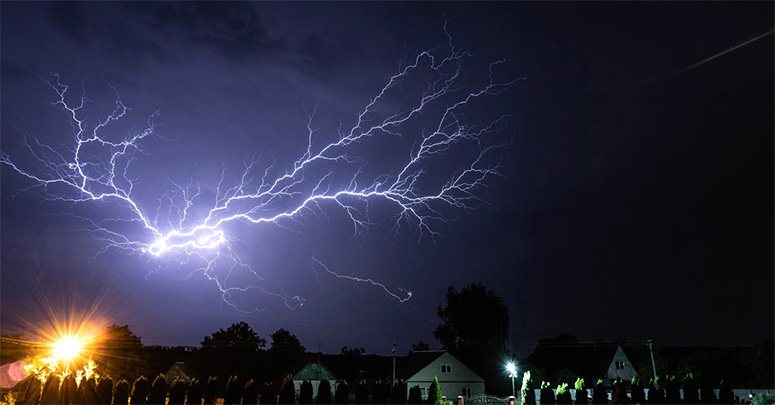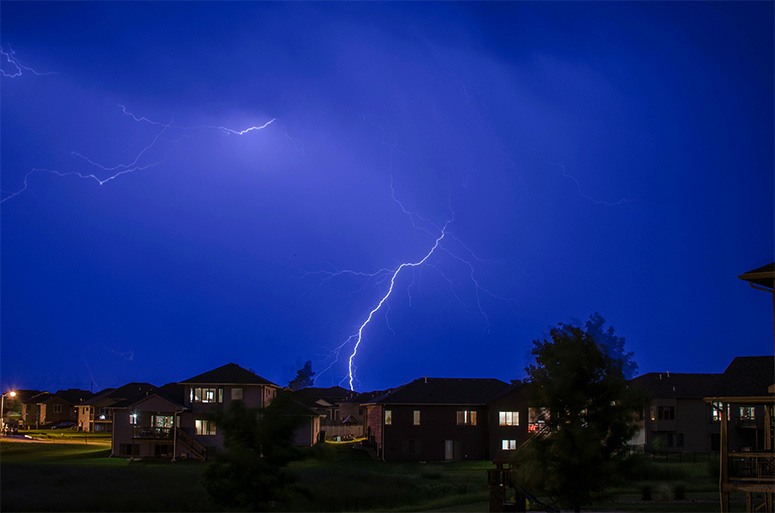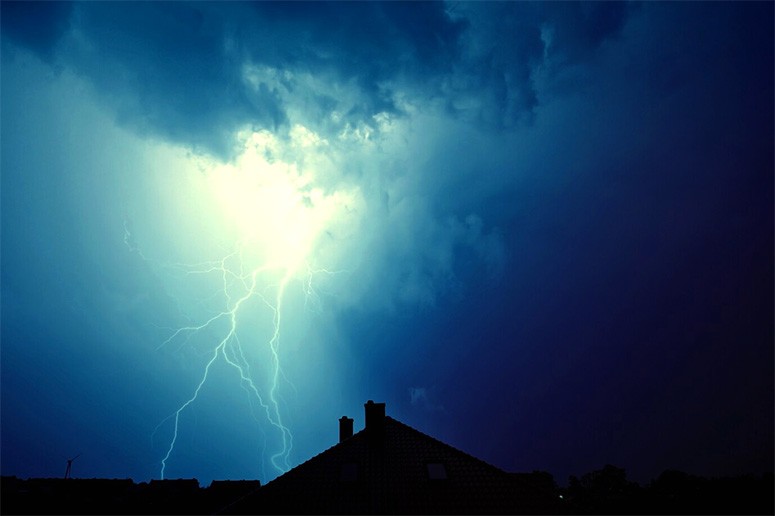Contents
Lightning is one of nature’s most breathtaking phenomena, but it also poses significant risks, especially when it strikes homes.
Understanding how lightning forms and what are the odds of lightning hitting your house can help you take protective measures.
This article explores what lightning is, the dangers it brings, and practical steps you can take to safeguard your home.
By grasping the statistics behind lightning strikes and learning about the chances of lightning hitting your property, you can better prepare and protect your home.
Whether you’re curious about the statistics or looking for safety tips, you will find helpful information to stay informed and protected.
What is lightning?
Lightning is a powerful natural phenomenon characterized by a sudden electrical discharge within the atmosphere, often occurring during thunderstorms.
It is a remarkable display of energy that can manifest as a bright flash and can reach temperatures exceeding 30,000 degrees Fahrenheit.
This meteorological occurrence not only captivates observers but also presents significant risks, including damage to structures, wildfires, and injuries to people and animals.
Understanding lightning is essential for improving safety measures, optimizing home protection, and reducing the risk of damage to property during stormy weather.
As climate change influences weather patterns, awareness about lightning becomes increasingly crucial.
How does lightning form?
Lightning formation occurs during thunderstorms, primarily driven by the buildup and discharge of electrical energy within clouds.
As moisture in the air rises and cools, it creates an environment conducive to the development of ice particles and water droplets, which collide and generate static electricity.
This process leads to the formation of a charge separation within the storm clouds that can eventually result in a powerful electrical discharge recognizable as lightning.
Various weather patterns and environmental factors contribute to the frequency and intensity of this phenomenon, making it essential to comprehend its mechanics for effective risk management and disaster preparedness.
What are the odds of getting struck by lightning?
The odds of getting struck by lightning can be surprisingly low, estimated to be about 1 in 1.2 million in a given year, yet this statistic can vary significantly based on geographic location, outdoor activities, and seasonal weather patterns.
Understanding these odds is crucial for risk assessment and emergency preparedness, especially in areas known as lightning hotspots.
Despite the low probability, awareness and safety measures are necessary, particularly during thunderstorms when the likelihood of lightning strikes increases dramatically.
Analyzing historical lightning statistics can provide valuable insights into regional risks and inform community safety initiatives.
What factors affect the odds of getting struck by lightning?
Several critical factors affect the odds of getting struck by lightning, including geographic location, seasonality, and individual outdoor activities.
Regions situated near larger bodies of water or elevated terrains often see increased lightning activity due to their unique atmospheric conditions.
Summer months generally contribute to a spike in thunderstorm frequency, increasing the risks for individuals engaging in outdoor sports or recreational activities during these times.
It’s also important to consider personal behaviors – for instance, those who frequently camp, hike, or engage in water sports must prioritize awareness of weather conditions and adhere to safety protocols.
By acknowledging their environment and adapting their activities accordingly, individuals can better manage their risk and enhance their safety measures against potential lightning hazards.
What are the odds of lightning hitting your house?

The odds of lightning striking your house are relatively low, but they can vary significantly based on several factors such as geographic location, building materials, and overall home design.
On average, a house can expect to be struck by lightning once in every 1,000 years, although homes in prone areas or those lacking adequate home protection systems face a higher risk.
This statistical insight calls for a thorough risk assessment to determine the best prevention methods, including installing lightning rods and ensuring proper grounding to safeguard your property against potential electrical discharge.
What type of houses are most at risk?
Certain types of houses are more susceptible to lightning strikes, particularly those constructed with conductive materials or located in geographic regions identified as lightning hotspots.
When considering lightning risks, homeowners often ask – what are the odds of lightning hitting your house?
Houses with flat rooftops or minimal landscaping may also present a higher risk, as they lack natural barriers that could deflect lightning.
Properties situated on elevated terrain tend to attract lightning due to their prominence in the landscape. Homes with metal siding or roofs made from steel are particularly vulnerable since these materials conduct electricity efficiently.
The proximity of larger trees or structures can provide some shelter but may also lead to side flashes if the main target is too close.
Homeowners should prioritize measures that enhance safety, such as regular maintenance of electrical systems and ensuring adequate grounding to mitigate potential dangers posed by lightning strikes.
What precautions can be taken to protect your house from lightning?
To protect your house from lightning strikes, several precautionary measures can be implemented, including the installation of lightning rods, proper grounding of electrical systems, and the use of surge protectors. Homeowners often wonder, “What are the odds of lightning hitting your house?”
These strategies help to safely redirect electrical discharge and minimize potential damage. Homeowners should also ensure regular home inspections to identify and address any vulnerabilities that could increase risks during thunderstorms.
By taking proactive steps, one can significantly enhance residential safety against lightning hazards.
Along with these core strategies, it’s essential to consider landscaping choices that can provide further protection. For instance, avoiding tall trees near the property can help reduce the likelihood of a direct lightning hit.
During storm preparations, homeowners should secure or bring indoors any outdoor furniture, as well as disconnect electrical devices to prevent damage from power surges caused by nearby strikes.
Employing these methods not only aids in safeguarding a residence but also fosters a greater sense of security for families during turbulent weather conditions.
What are the dangers of lightning hitting your house?
The dangers of lightning hitting your house can be severe, leading to significant structural damage, electrical fires, and other hazardous conditions.
When lightning strikes, the immense energy can cause direct damage to the building, ignite fires, and disrupt electrical systems, potentially resulting in costly insurance claims and repair bills.
Understanding these dangers is crucial for homeowners to implement effective safety measures and ensure emergency preparedness during thunderstorms.
By recognizing the risks, individuals can actively work to protect their homes and loved ones from the potentially devastating consequences of lightning strikes.
Can lightning cause fires?
Yes, lightning can indeed cause fires, which is a significant concern for homeowners during thunderstorms. When lightning strikes a home, the intense heat generated can ignite flammable materials, leading to devastating fires that can spread quickly throughout a structure.
Homeowners should consider the question, “What are the odds of lightning hitting your house? If electrical systems are compromised, the risk of electrical fires increases, necessitating a proactive approach to home safety and fire prevention.
Understanding the relationship between lightning strikes and fire risk is essential for effective disaster preparedness.
In fact, the probability of lightning ignition is heightened under specific conditions, such as dry weather preceding a storm when combustible materials, like dead leaves and timber, accumulate around properties.
Inadequate maintenance of electrical systems can create vulnerabilities that lightning exploits, resulting in short circuits and additional fire hazards.
Homeowners should consider installing surge protectors to safeguard their electrical equipment and regularly inspect their property for fire safety compliance.
By being informed about the risks associated with lightning, individuals can contribute to damage prevention measures that not only protect their homes but also enhance their overall fire safety strategies.
Can lightning cause structural damage?
Lightning strikes can cause significant structural damage to homes, often resulting in costly repairs and safety hazards. The immense force of a lightning bolt can impact roofs, walls, and foundations, compromising a building’s integrity.
Assessing the risk of structural damage is crucial for homeowners, particularly in areas prone to thunderstorms.
Implementing protective measures, such as proper grounding and lightning rods, can help mitigate potential damage and ensure a safer living environment.
Understanding the various types of structural damage is essential for effective home protection strategies.
Lightning can create electrical surges that may result in fire or destroy electrical systems, while direct strikes can puncture roofs, create explosive pressure waves, or shatter windows.
Such damage can not only be expensive to repair but can also lead to dangerous conditions like mold growth or compromised structural supports.
To safeguard against these risks, homeowners should conduct regular assessments of their property and consider consulting with experts on reinforcing their structures.
This proactive approach can significantly reduce the likelihood of extensive damage due to lightning strikes.
Can lightning cause electrical damage?
Lightning can cause severe electrical damage to homes, impacting electrical systems and appliances through power surges. This damage can lead to malfunctions or complete failure of critical systems, resulting in costly repairs and potential safety hazards.
Homeowners should prioritize surge protection and ensure their electrical systems are designed to withstand the forces of lightning strikes.
Understanding the implications of electrical damage from lightning is vital for maintaining home safety and effective emergency preparedness.
These unpredictable weather phenomena can create intense voltage spikes that overwhelm standard circuit protection measures, leaving many homeowners vulnerable.
Common examples of electrical systems that can suffer include HVAC units, refrigerators, and sensitive electronics, all of which rely heavily on stable power sources to function correctly.
Implementing surge protection devices is not merely a precaution – it’s a crucial step in safeguarding valuable assets from the devastating consequences of lightning strikes. Regular maintenance checks of home wiring and grounding systems can enhance overall resilience.
By understanding these risks and investing in proper surge protection, homeowners can significantly reduce repair costs while ensuring their dwellings remain safe and functional during storms.
What to do if lightning hits your house?
If lightning strikes your house, it is crucial to follow specific steps to ensure safety and assess potential damage.
- First, remain calm and avoid using electrical systems until they have been inspected for damage;
- Next, check the property for signs of structural damage, fires, or electrical issues;
- Promptly contacting emergency services or home repair professionals is essential for assessing the extent of the damage and initiating necessary repairs.
Being prepared with knowledge of emergency response procedures can significantly reduce risks associated with lightning strikes.
How to check for damage?
To check for damage after a lightning strike, begin with a thorough visual inspection of your home for any visible signs of structural damage or fire.
Pay close attention to roof integrity, siding, and any outdoor structures. It is essential to assess your electrical systems for malfunctions or unusual behaviors, which could indicate potential damage.
Conducting a comprehensive damage assessment is vital to ensure the safety of your home and its occupants while planning for any necessary repairs.
After the initial visual check, enlist the expertise of a licensed electrician to perform a detailed evaluation of the electrical systems.
This should include inspecting circuit breakers for tripping or damage, checking outlets and switches for signs of scorching, and testing appliances that may have been affected.
Next, consider examining any surge protectors or other safety devices, as these are crucial for safeguarding against future strikes.
Addressing both structural and electrical concerns promptly is not only a matter of safety but also ensures long-term protection for your property, laying the foundation for necessary repairs and restorations.
Who to contact for repairs?
If there is damage from a lightning strike, contacting the right professionals for repairs is crucial to restore safety and functionality to your home.
This process begins with reaching out to emergency services when immediate safety concerns arise, such as fires or potential electrical hazards that could threaten occupants.
Following that, it’s essential to engage licensed contractors who are well-versed in structural repairs, as they can assess any physical damage to the property thoroughly.
Electricians with expertise in electrical systems should be included in the restoration process to ensure that any disrupted wiring or circuits are safely addressed.
By ensuring that qualified professionals manage repairs, homeowners can significantly reduce the risk of additional complications while enhancing the overall safety and integrity of their living environment.
How to stay safe during a lightning storm?

Staying safe during a lightning storm requires proactive safety measures and awareness of best practices to minimize risk. Seek shelter indoors away from windows, doors, and electrical appliances, as these can increase the risk of injury during a lightning strike.
If caught outdoors, find a low-lying area and avoid standing under trees or near tall structures.
Preparing for storms involves understanding weather forecasts and disaster preparedness strategies to ensure your safety and that of your family during these dangerous conditions.
What are the odds of lightning hitting your house? While the probability may be low, the potential for severe damage underscores the importance of taking storm safety seriously.
What precautions should you take inside your house?
Inside your house during a lightning storm, it is crucial to implement several safety precautions to reduce risks. Stay away from electrical appliances and devices, as surges may occur, and avoid using wired phones.
Ensure that your home is equipped with surge protectors and that all electrical systems are properly grounded. Staying clear of windows and doors can help you avoid injury from flying debris or glass.
These indoor safety measures are essential for effective emergency preparedness during thunderstorms.
Ensure that you have a reliable emergency kit on hand, containing essentials such as:
- water;
- non-perishable food;
- flashlights;
- batteries;
- a first aid kit.
It’s wise to familiarize all household members with these safety protocols so that everyone knows how to react in the event of an unexpected power surge or electrical fault.
Keeping a battery-operated radio can also provide vital information about the storm and nearby conditions.
By taking these steps, your household can stay protected, ensuring not only safety from lightning hazards but also readiness for any unforeseen emergencies. And while you might still wonder, what are the odds of lightning hitting your house, being prepared remains the best defense against the unexpected.
What precautions should you take outside your house?
When caught outside during a lightning storm, it is essential to take immediate precautions to ensure your safety. Seek shelter in a sturdy building or a hard-topped vehicle, avoiding open fields, tall trees, and metal structures that could attract lightning.
Stay low to the ground and avoid lying flat, as this can increase the risk of injury from ground currents. Being aware of your surroundings and understanding emergency response strategies can significantly enhance your safety during dangerous weather conditions.
In addition, it’s advisable to monitor weather updates through reliable sources and establish a communication plan with family or friends in case of emergencies.
If indoors, stay away from windows and electrical appliances to minimize the risk of injury from lightning strikes.
Consider joining community safety initiatives that provide education on responding to severe weather.
Carrying a flashlight and a fully charged mobile phone can also aid in securing a sense of safety and ensuring swift communication if help is needed.
Always remember, preparation can make the difference between a dangerous situation and a safe escape.
You can find our FAQ about the odds of lightning striking your house further down the page.
Uncover the wonders of probabilities and rare events. Satisfy your curiosity and explore a wealth of intriguing topics at WhatAreTheOddsOf.NET.



